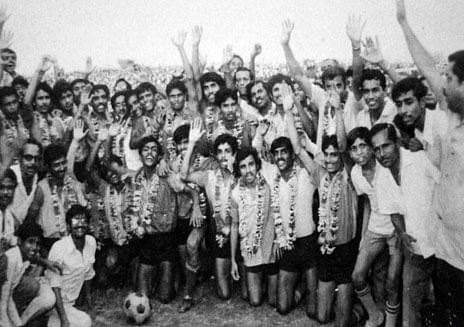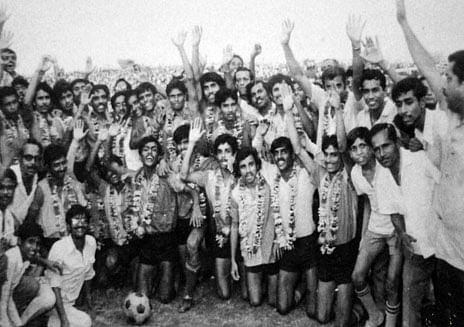
East Bengal's memorable 1973 DCM tournament triumph

East Bengal after the triumph
The 29th of October is the 40th anniversary of arguably the finest performance by an Indian club side against a quality foreign team. Way back in 1973, on this day, East Bengal emerged victorious in the DCM tournament final against the mighty Dok Ro Gang of North Korea, which had six players who had excelled for their country in the 1966 World Cup. The final on Sunday, 28th Oct, and the replay the next day, both ended in goalless draws. However, Dok Ro Gang refused to play extra time on October 29 and East Bengal were declared winners.
In 1973, the all-Indian East Bengal team played superlative football against a side which had destroyed the other Indian clubs on their way to the final. East Bengal has the best record against foreign clubs, having won 78 of the 191 matches they have played so far, but their 1973 DCM victory was probably their greatest hour.
It may be recalled that the DCM tournament held in Delhi was the first to regularly invite foreign clubs to participate. This trend started in the 1968 DCM tournament, when Ethiopian Airlines and Ceylon XI were the foreign participants. The first North Korean club side to play in India was Youngmen FC which annexed the 1972 DCM tournament.
The North Korean club (Dok Ro Gang) that contested the 1973 DCM tournament was awesome to behold. After they thrashed Leaders Club, inclusive of Inder Singh, Sri Kishen and Gurkripal Singh, 7-0 in the quarterfinals, many East Bengal players got overawed. Even the spirited Bade Mian of the Maidaan, Mohd. Habib, felt they could not match the North Koreans. Many of the players including the phlegmatic Sudhir Karmakar and the hyperactive midfielder Gautam Sarkar felt that Dok Ro Gang was far superior to the North Korean club Pyongyang City Club that East Bengal had beaten 3-1 in the IFA Shield final in September 1973.
Many spectators and experts alike who had seen Dok Ro Gang whip Leaders club 7-0 on Sunday 21 October, felt that the North Koreans were the best club side that had ever played in India. In the quarterfinal they led Leaders Club 6-0 at half time, with a devastating display of speed, power and sharp finishing. One of India’s leading teams at that time, Leaders Club was left chasing shadows in the first half. At half time, the assistant secretary of the DCM tournament, R.K. Gupta took me to the North Korean dressing room and asked me to tell them not to go all out in the second half and humiliate one of North India’s most popular clubs. The North Koreans then as now were a mystery but I managed to convey the message through an interpreter and they slackened the pace in the second half and scored just once.
However in the previews before the final, all the newspapers, in Hindi, English and regional languages had made Dok Ro Gang overwhelming favourites to win the DCM title. It was felt that all East Bengal could do was reduce the margin of loss. In the early 1970s, North Korea was considered one of Asia’s best teams and their club teams were also rated the best in the continent.
However the astute P.K. Banerjee had other ideas and ultimately had the last laugh. In the two days gap before the final, Coach P.K. Banerjee used innovative motivational tactics to get the players charged up. Tactical classes were held on the roof of Duke Hotel, in Daryagunj, where East Bengal was staying. PK bought some bangles and told the players to wear them if they were scared of a fight. Incensed at such verbal taunts, they got motivated and he explained his plan of playing possession football in a 4-5-1 formation to deny North Koreans the ball and frustrate them. In the final this plan worked.
The East Bengal players were also highly motivated as the entire Ambedkar stadium cheered them vociferously, including the large section of Punjab supporters, known as “L Club” who were traditionally against all Calcutta based teams. This change in heart was also due to P.K. Banerjee. On successive evenings he met Banarsi Das, the President of L Club and other supporters of Punjab clubs. Over drinks he convinced them that in the final, they should forget club loyalties and it was a matter of prestige to support the Indian club.
East Bengal was the underdog in the final. However cleverly coached by the high profile motivator P.K. Banerjee, East Bengal outthought the North Koreans by using a flexible 4-5-1 system. Mohd. Akbar was the lone front runner and East Bengal’s packed midfield enabled them dominate play. As East Bengal outnumbered their opponents in midfield it prevented the North Koreans from launching counter speedy attacks, which was their forte.
In fact East Bengal had the better chances. In the 90th minute of the final, Bhowmick and Akbar played a slick wall pass at the edge of the 18 yard box. This move bisected the Dok Ro Gang defence and set Akbar through on goal. However he angled his shot wide as the North Korean goalkeeper advanced.
The North Koreans were so impressed with East Bengal’s display in both finals that their embassy in Delhi made recordings of the finals and sent them back to Pyongyang for careful study and analysis. The North Koreans feared that India, with six East Bengal players in their ranks would be their most dangerous opponents in the 1974 Asian Games.
The historic East Bengal playing eleven in both finals were:
Goalkeeper: Arun Banerjee,
Defenders: Sudhir Karmakar, Ashok Lal Banerjee, Shymal Ghosh and Probir Mazumdar.
Midfielders: Gautam Sarkar and Samaresh ‘Pintu’ Chowdhury.
Forwards: Subash Bhowmick, Mohammed Akbar, Mohammed Habib and Swapan Sengupta.
Reserves used in the final: Biman Lahiri and Chandan Gupta.